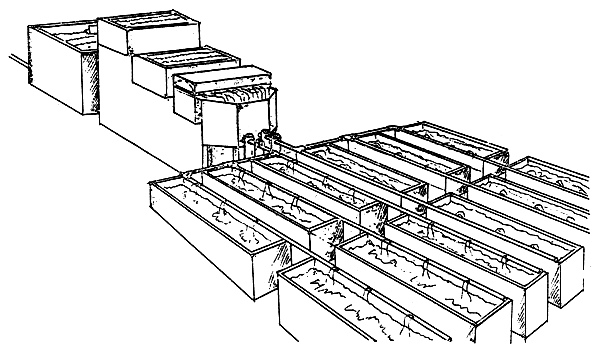Molluscs are filter feeders and are most affected by red tide organisms which are harmful to human beings. Some incidences of red tide poisoning due to consumption of mussels occurred in the Philippines which were fatal to the consumers. When this happens, shellfish farmers lose their market and their business also slumps.
In order to prevent consumer bias against the consumption of oysters and mussels and also to upgrade the quality standard of molluscs in the market, depuration should be required. This is a service which could be provided by marketing authorities particularly at the market centers. Depuration facilities could be installed so that retailers or wholesalers of molluscs could be given such services prior to selling mussels and oysters in the retail markets.
It was estimated that a 5-ton capacity shell-fish depuration plant operating every 24 to 36 hours would be able to depurate shellfish at a cost of 0.10 per kilogram of oyster or mussel (Personal Communication, 1989). A schematic illustration of a depuration plant is shown in Figures 21 and 22.
It would be strategic to install a depuration plant at the vicinity of shellfish producers such that the cost of depuration may be borne by the producers as part of their costs of production. Buyers could, therefore, purchase their products from the plant.
A government policy on quality standard of molluscs in the market for sale and consumption should be made so that the public's health and safety is assured.

Figure 21. Perspective view of shellfish purification plant
(From: Almazan, R., 1989)

Note: Arrows indicate water flow
Figure 22. Schematic drawing of shellfish purification plant
(From: Almazan, R., 1989)
Table 10. Potential areas for mussel culture
| Location | Potential area (ha) | Sources | |
|---|---|---|---|
| North Sumatera | 200 | 2, 3 | |
| 1. | Tj. Balai | ||
| Riau | 3 000 | 1 | |
| 2. | Teluk Bintan | ||
| Lampung | 3 000 | 2 | |
| 3. | Kuala Penet, Maringgai | ||
| West Java | 4 000 | 1 | |
| 4. | Banten Bay | ||
| 5. | Ketapang, Tangerang | ||
| Jakarta | 2 000 | 1 | |
| 6. | Kepulauan Seribu | ||
| Central Java | 500 | 1 | |
| 7. | Jepara | ||
| East Java | 4 500 | 1, 4 | |
| 8. | West part of Madura | ||
| 9. | Pasuruan | ||
| 10. | Probolinggo (Gili Ketapang) | ||
| 11. | Kwanyar, Madura | ||
| West Nusa Tenggara | 500 | 1 | |
| 12. | Labuan Lombok | ||
| 13. | Batu Nampar | ||
| Total | 19 799 | ||
1 Estimated from topography map
2 Estimated from actual sites
3 Interviewed resource person
4 Pagcatipunan, et. al., 1981 From: Mintardjo, Kisto, 1988